The eyes of the bees and their ability to see
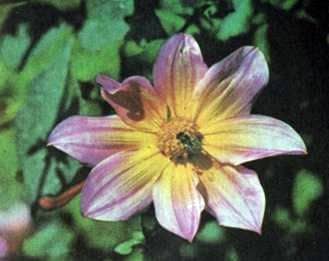
If the reader ever had breakfast at a village in the air, there is honey, then probably the bees attracted by the honey smell were also on the table. In this case, you can always conduct a simple experiment, which requires a sheet of red and two identical sheets of blue paper, as well as a little patience.
We remove from the table a jar of honey, but we leave on it a sheet of blue paper with a few drops of honey. A little time will pass, and the bees, discovering drops of honey, will begin to fill their honey cinders. Delivering honey to their native hive, they will fly back in a few minutes, to once again use a rich source of bribes.
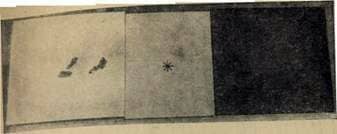
Fig.43. The bees of which before that were fed on a blue sheet (the place of feeding is indicated by an asterisk (*), look for food on a clean blue sheet (left), leaving a red sheet of paper (on the right) unattended.
Let them several times fly back and forth, then put the red and blue sheets of paper on the right and left of the previous feeding place, but without honey, and remove the paper with honey. Bees are not at all interested in the red leaf, and over blue they spin and even descend on it, although this time nothing can be found there: there is even a smell of honey attracting them. Consequently, they noticed that the food was on a blue sheet, and is able to distinguish the blue from the red.
From this experience, the conclusion is that bees distinguish colors. But the situation is not so simple at all, and this conclusion is too hasty.
Often there are people whose color perception is more or less limited compared to normal. There are people (although such cases are quite rare), which do not distinguish colors at all. Such a “color blind man” sees a landscape rich in paints such that a person with normal vision can see it only on an ordinary black and
A person who does not discern color sees a variety of forms of objects, but everything seems gray to him on a gray background and individual colors appear only in gray color of varying degrees of brightness. If we offer sheets of blue and red paper to such a completely color-poor person, he can distinguish them from each other and never confuse. But he distinguishes them not by color, which does not exist for him, but in terms of brightness, since red seems to him very dark, almost black, and blue – light gray. His impressions can be compared to the ones we get when we consider a black and white photograph (see Figure 43). Thus, for each color there corresponds a certain degree of brightness.
It is clear that on the basis of our experience it is impossible to decide whether the bees distinguish red and blue leaves by their color or, as completely color-blind creatures, in terms of their brightness. Therefore, if we want to draw the right conclusion, we will have to put the experience somewhat differently.
The question arises whether a bee appears to be painted blue or to her, as well as to a person suffering from color blindness, it seems that it is a gray tone of a certain brightness. Since we can not know how bright the blue color would be to the bee’s completely colorless eyes, we will have to check whether bees can distinguish all the tonalities of gray. For this purpose we use a set of sheets of gray paper of varying degrees of brightness, from completely white to deep black. We suggest that the bees who received the food on the blue leaf choose a clean blue sheet without feed among a set of gray sheets of varying degrees of brightness located in an arbitrary order.
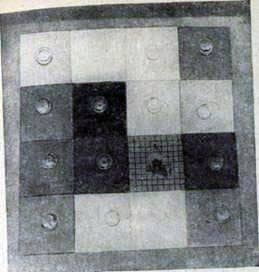
Fig.44. On the blue sheet of paper, as well as on the gray sheets of different density of coloring spread out around it, there are empty cups for food. Blue-trained bees gathered on a blue sheet of paper (shown shaded in the figure), thus proving that they distinguish this color from all shades of gray.
Bees and now confidently fly to the blue sheet and fall on it. Therefore, they can distinguish between blue colors among all possible shades of gray, and only now they have proved to us that they see blue as color or color.
In these experiments, as well as during the training on odor, it is more appropriate to use odorless sugar syrup instead of fragrant honey, and in order to avoid the bees training to a certain place, it is often necessary to change the relative position of the colored sheets of paper. After one or two days, the training is so well established that the bees visit the blue leaf in the case when all the sheets of paper are covered with glass. The bees, therefore, inform us that the decisive thing for them really is the appearance of the blue leaf, and not some odor that is not perceived by our nose, which, of course, can not be felt through the glass.
Exactly the same experience with a yellow sheet of paper is also good. But if we take a sheet of bright red paper, the result of the experiment will be astounding. Bees, trained on red, visit not only the red leaf, but also staggered sheets of black and dark gray paper. Careful and prolonged training does not change anything. The bees are confused with red and black colors. Red color for them does not exist. Like the color of a blind man, they perceive it as dark gray.
But in another respect, bee eyes are superior to normal human eyes. They perfectly perceive invisible to us the ultraviolet rays, that is, the rays “located in the spectrum behind the violet.” The thing is this.
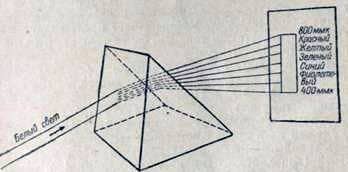
Fig. 45. The appearance of a spectrum with the transmission of light rays through a prism.
A white sunlight is a mixture of light rays of different wavelengths. If it is passed through a prism, its rays will be refracted differently and, depending on the wavelength of each of them, a color band of the spectrum will appear. In nature, this phenomenon can be seen in the formation of the rainbow. The rays with the longest wave we see are red. In absolute terms, of course, these “large” light waves are still so small that they are measured in millimicrons (millimicron-millionth of a millimeter). From red rays with a wavelength of 800 mk, the color band of the spectrum reaches violet, in which the part visible to us ends with waves of 400 mk length. However, the sunlight contains even shorter-wave, namely ultraviolet rays. For the bee eye, the light becomes invisible only at a wavelength of 300 m. The ultraviolet appears to bees in a special color tone and, moreover, the brightest and brightest color of the spectrum.
If the color rays obtained as a result of the expansion of the white beam are reassembled together, then we will again perceive the white ray. A similar impression of white color can be obtained by selecting from the spectrum only three “basic” color beams – red, green, blue – and mixing them in the correct ratio, or if you do the same experiment with certain pairs of color rays (additional colors, for example red and bluish – green).
Softly, almost unnoticeably, the colors of the spectrum go one to the other, from red, through yellow, green, blue-green, blue and violet. The final colors, red and violet, can also be interconnected by transitional steps, if the red and violet rays are mixed in different proportions. This will create purple tones that are not contained in the spectrum itself, but with which you can close the color wheel.

Fig. 46. The color circle of man (a) and bee (b) (schematically). The three primary colors are underlined. Mixing them, you can create intermediate colors. Additional colors in the picture are placed one against the other.
Experiments of recent years have shown that the corresponding laws of mixing colors are also suitable for bees, although their eyes are arranged quite differently than human eyes. For bees, there is also a “white” color that is formed by mixing both the colors of the spectrum visible to the bees and the three main colors for the bees – yellow, blue and ultraviolet (or from two additional flowers for bees) and are unlike any other color. For them, there are also new color tones that are not contained in the spectrum, if the light beams of the final parts of the bee spectrum (yellow and ultraviolet) mix one another; in the sense of the human concept of color, we can speak of the existence of “bee purple” color. The orange, yellow and green colors for bees are more similar to each other than to us. The same can be said about blue and violet. As far as ultraviolet rays are concerned, a new color tone (“purple violet”), unknown to us, appears on the border of ultraviolet for bees.
In general, the color vision of these insects is much more similar to ours than is commonly thought. The main difference lies in their immunity to red and extreme susceptibility to ultraviolet. What the colors really look like to bees, of course, we have no idea about this. After all, we will never be able to recognize the inner sensation of even our neighbor, when he calls colors just like we do.
Eyes of bees and coloring of flowers.
Let the one who believes that all the splendor of the colors of the Earth is created for the delight of the human eye, will study the peculiarities of the coloring of flower haloes and the perception of its winged visitors – and it will immediately become much more modest.
First of all, it catches the eye that it is not all the flowers that give the flowers themselves. Many of them, for example grasses and grasses, conifers, elm, poplar and others have very small, imperceptible flowers without a smell that do not emit nectar. Insects do not visit such flowers. The pollen is transferred by chance to wind and pollination is provided only because the flowers have excessive stocks of dry, easily scattered pollen. These “wind-pollinated” plants can be countered by “insect pollinated”.
Their flowers give off nectar and attract flying visitors, carrying pollen in the shortest and most reliable way. These flowers immediately attract attention due to either the flavor that they emit, or the variegated coloring of the coronets, or, finally, the combination of the two, are flowers in the full sense of the word.
There is an idea of a deeper interdependence between flowers and insects. Like the owner of a diner, which uses a bright signboard to attract the attention of a passerby, the colorful flags of flowers from afar still point the bees to the place where nectar is waiting for them and where they should look for the mutual benefit of the host and guest. But if the color of the flowers has a certain effect on the eyes of the pollinators, we can assume a relationship between the peculiarities of the coloring of flowers and the color vision of insects. Such a relationship does exist and is very clear.
Long before the color vision of the bees was studied, the botanists noticed and more than once expressed surprise in this regard that in our flora very rare red flowers occur. But this is the only color that is not perceived by bees as a color; such flowers are inconspicuous for insect pollinators. Most of the so-called “red” flowers of our flora – heather, alpine rose, red clover, cyclamen and others – are not of a purely red color, which we are talking about, but with a blend of blue – purplish red. But, maybe, flowers in general it is difficult to produce bright red paint? No, it’s not. In tropical plants, some of which, due to the unusual coloring of their flowers, are willingly bred in orchards and greenhouses as Decorative, it is very often the bright red color of the coronets. There are no grounds to consider,
However – and this has also been known to botanists for a long time – precisely these bright red flowers of the tropics are pollinated not by bees and not insects at all, but by small birds – hummingbirds and nectarines, which, floating in the air in front of a flower, immerse its long beaks into it and suck it abundantly the nectar that is nourished.
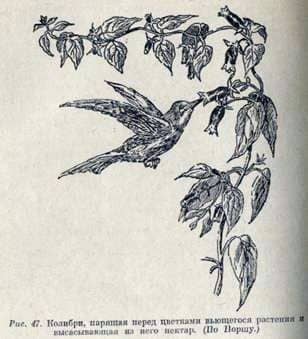
It is established that exactly that red color that the bees do not perceive seems especially bright to the eyes of birds.
It has long been known and repeatedly discussed (before it was explained by experiments conducted in recent years), yet another relationship between the coloring of flowers and their visitors: few of the flowers of our local flora, the color of which approximates to pure vowel color, such as carnations, goritsvety , resin is pollinated for the most part not by bees, but also not by spirits and beetles, but mostly by day butterflies, which with long proboscis extract nectar from the bottom of especially deep flower tubes. These flowers seem to be specially adapted to pollination by butterflies which, in contrast to bees and other insects, perceive red color.
It is really not necessary to demand more. The color of the colors reflects the ability of their visitors to perceive or not to perceive the red color. It should be expected – and it was confirmed – that the susceptibility of the eye of the bee to the ultraviolet will also find the answer in the coloring of the flowers. However, this interdependence is more difficult to detect because of the inability of our own eyes to perceive ultraviolet rays.
The first surprise was presented to us by poppy flowers, belonging to a few flowers, the color of which approaches a pure red color. Nevertheless, they are assiduously visited by bees. The fact is that the petals of these flowers, in addition to the red light rays, which do not matter to bees, also reflect the ultraviolet rays. Thus, poppy for us red, and for bees an “ultraviolet” flower. The same can be said about red flowers of beans. The reasoning that these flowers have a color that is not perceived by insects that visit them has proved to be unfounded. White flowers also seem to be painted.
The second amazing discovery in this area was that all white flowers-imperceptible to our eyes-are filtered from the sun’s rays by short-wave ultraviolet rays. We do not notice whether the light ray in our perception contains ultraviolet light or not. But the ultraviolet-sensitive bee-eye, the “white” color, from which the ultraviolet is taken away, according to the laws of color mixing, appears to be complementary to the ultraviolet “bluish-green” color, is of great importance, because the “white” light beam formed as a result of mixing all perceived by the bee color rays (including ultraviolet), for bees is less memorable than a colored light beam.
Training for such a white color represents a known difficulty – and we would in vain seek for such a color in the plant world. White stars of daisies, which we see in the meadow, the bees appear shining blue-green stars. White flowers of apple trees, white bells, white bindweeds, white roses – they all have colored “signs” for the “visitors” who understand them.
If in one case the petals of flowers owe their colorful clothing to the absence of ultraviolet, then in other cases the reason for their enchanting coloration, which remains hidden from us, is in its addition. Such, for example, are yellow flowers of icteric, rape and mustard seed, which for us hardly differ from each other in color and shape. Bees could laugh at us! “Yellow” for them only a jaundice. Rape flowers also reflect a little ultraviolet and have therefore a light purple hue. The sowing mustard, the flower petals of which reflect a lot of ultraviolet, therefore acquires a thick “purple-red” color for the bee eye, whose ability to distinguish all three types of color is easily provable.
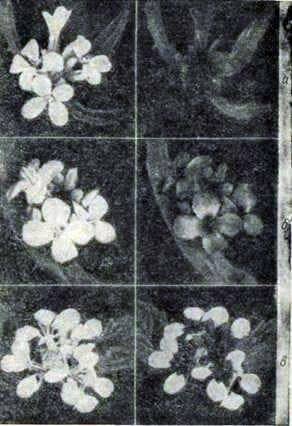
Fig. 48. Flowers: a – icteric, b – rape and c – mustard seed, photographed in yellow light (left) and in ultraviolet (right). The different degree of reflection of the ultraviolet creates for the bee eye a different color of the flowers, which we see equally yellow.
In Fig. 48 shows all three of the above-mentioned flowers, photographed through filters that pass only the yellow light (on the left) and only the ultraviolet (frame). We see that yellow light is equally reflected by all three flowers, whereas ultraviolet, not perceived by our eye, they reflect with varying strength. This applies to many other flowers that appear to us equally yellow or blue.
The place where you can find nectar on a flower is often marked by a color mark that is striking in the eye – a “nectarean spot”. Everyone knows a yellow ring in a blue forget-me-not flower, in the center of which the bee, in order to reach the nectar, must enter its proboscis.
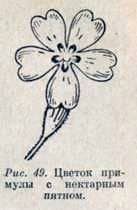
In primulas, light yellow flowers have dark yellow nectarean spots, and there are many such examples. If the color of the whole flower plays the role of a “signboard”, from afar attracting a “visitor”, then nectarean stains direct it to the “restaurant” in a more pleasant way than our prosaic index.
The color mark is very eloquent due to the fact that nectarean stains almost always have a stronger, and often even completely different, smell than the surrounding parts of the flower. Optical nectarean spot is for bees simultaneously and an aromatic stain. We do not notice this because when you draw in air with your nose all the aromatic substances are mixed. For a bee which perceives smells “plastically” with its antennae, such aromatic marks are of particular importance.
Anyone who could see the world through the eyes of a bee would be amazed by discovering twice as many flowers with magnificent nectarean spots as our eyes, which do not perceive ultraviolet, are able to detect. The spectacle that appears to the bee-eye can be made visible for ourselves by photographing the flowers through three color filters, whose translucency corresponds to parts of the spectrum of the three main colors perceived by the bees.
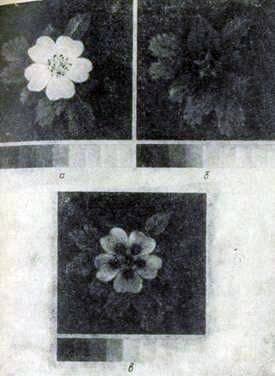
Fig. 50. Flowers and leaves of the creeping tent, photographed: a – in yellow, b – in blue, c – in ultraviolet light.
The flowers, which seem to us bright yellow, strongly reflect the rays in yellow light, do not reflect them in blue, and only the extreme parts of the petals strongly reflect in the ultraviolet light. Thus, an invisible nectarean spot appears, bright yellow in a purple frame, and due to a weak uniform reflection of the rays located in the three parts of the spectrum, the bees are colorless.
In Fig. 50 depict the same yellow flowers for us creeping caulks; The light color of the petals on the image taken through the yellow filter shows that the yellow rays are reflected strongly and evenly. Their dark color in the figure on the top right (blue filter) allows us to conclude that the blue light rays are absorbed. Photographing through the ultraviolet filter (below) reveals a striking phenomenon – an invisible nectarean spot. The extreme parts of the petals reflect ultraviolet, therefore, they have a coloration consisting of a mixture of yellow and purple flowers – “bee purple” color. The inner part of the flower absorbs ultraviolet, so for the bee’s eye a purely yellow nectarean spot appears surrounded by a purple fringe. The influence of these nectarean spots hidden from us can be understood by conducting experiments with bees.
Looking at Fig. 50, we can draw another conclusion, which, in essence, gives a deep meaning to all the magnificence of flowers. Together with the flowers were photographed and green leaves. They reflect the light rays of the three main parts of the spectrum for bees quite evenly, and only in the yellow region – a little more. This conclusion is also true for other foliage and means that the leaves that appear to us green, the bees see almost colorless gray with a pale yellow tinge. But the more intense on this faded background are the colorful flowers.
The nature lover, of course, will not cease to enjoy the flowers, even if he finds out that they are not meant for his eyes at all.
On the structure of the eyes.
Two people can have the same and perfectly normal color vision, but have a different visual acuity. One of them, perhaps no worse than an Indian, can look at all the details at a distant distance, and another, extremely short-sighted, becomes without glasses ridiculously helpless. The ability of the eye to distinguish colors, we will not establish even with the most thorough anatomical autopsy, because it is based on the subtlest features of the internal structure, lying beyond even microscopic examination. But the distinct or diffuse perception of the shape of objects by the eye is most closely connected with the more “rough” features of its structure: anatomists already in the outer structure of the eye can judge that it belongs, for example, to a short-sighted person.
But if we open the eye of a bee or some other insect, striving to determine its working capacity, all our knowledge acquired on the basis of studying the human eye can no longer help us. It is especially tempting for a natural scientist to trace the ways and means by which nature achieves the same goal in beings as diverse as the human being and the bee.
The fineness of the structure of the eye of an insect is much more multifaceted than the human eye. To understand them to the end is possible only with serious study, and as a prerequisite for this, we must draw some arguments in the field of physics. However, the main difference in the structure of the human eye and insects can be explained in a few words.
The human eye can be compared with a camera. A hole in the front wall of the chamber corresponds to a visual hole in the human eye – the pupil. Just as the photographer in bright illumination reduces the diaphragm to reduce the intensity of illumination, so does the iris (diaphragm), shrinking, reduces the pupil and protects the inside of the eye from excessively bright light. The lens of the camera corresponds to the lens of the human eye. Both of them have the same shape and the same purpose. When we look at the distant luminous point A, which radiates light from all directions, the lens collects rays incident on it through the pupil and connects them to one point at the bottom of the eye (a).
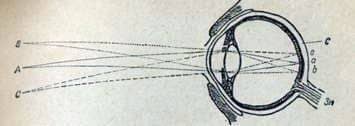
Fig. 51. The eye of a person. у – the retina; ZN – the optic nerve.
If we imagine another luminous point B on A, the lens will collect the rays emanating from it to the fundus at a location slightly lower than (b), and the rays from the third point (C) located below the first (A) will gather at point (c) at the back of the eye above the first point (a). Instead of three glowing points, the reader can imagine three stars in the sky or three lit candles placed one above the other.
These considerations remain valid for any point that does not itself radiate, but is illuminated by a daylight or artificial light source. Then she throws the light that falls on her in all directions, just as if she herself radiated it. Any object that is in our field of vision can be imagined as consisting of a set of individual points, and for each of them everything that we deduced above for our three points A, B and C is applicable above. Thus, the lens throws to the eye bottom a small, inverted, but accurate image of the subject under consideration, just like a camera lens – on a frosted glass or an inserted photographic plate.
A significant difference between the camera and our eye is the use of the resulting image. In the chamber on the plate, the image obtained at a given moment of time is imprinted and, so to speak, preserved. In our eye, the place of the photographic plate is occupied by a reticular shell, which perceives the image with all the distributions of light and shadows on it, and it arises again every moment and continuously changes.
The main part of the mesh shell consists of the finest mosaic of rod-shaped elements (they are so small that it would take many hundreds of them to fill a distance of 1 millimeter), and all of them are connected to the brain by the thinnest nerve fiber. Each luminous point, the image of which falls on the mesh envelope, is transmitted to the brain through appropriate nerve fibers, and only there, and not on the mesh shell itself, a certain perception arises – from every single point flashed in the night darkness and from the infinite mass of individual dots, which in the light of the day fill the entire field of our vision and merge with each other into a single visual image.
Sometimes the question arose: why does the world not appear to us upside down, if everything is reflected in our retina in an inverted form? This question is meaningless already because the image of the visible is realized in us not by the retina, but by the brain, in which all particles of the image have already managed to settle in a different way for a long time, as the nerve fibers leading to the brain informed him.
The eye of the bee, as well as the eyes of other insects, has neither a pupil, nor an iris, nor a lens. The mesh shell at the bottom of the eye can be compared to the mesh shell of the human eye. But the image on this reticulated shell appears differently. The bee has very prominent eyes located on the sides of the head. If we look at their surface through a strong lens, then it seems delicately divided into small areas, facets, and therefore such a visual organ is called a faceted eye.
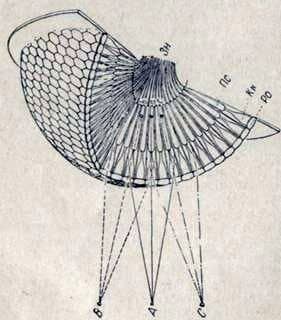
Fig.52. Eye of the bee (outline). The rosary sheath; Kc is the crystalline cone; Ps – retina rods; ZN – the optic nerve. The points A, B, and C in the field of view correspond to the images of the points a, b and c appearing on the retina. The image is direct.
Thus, the appearance of the eye of the bee already speaks of its dissimilarity in its internal structure with the human.
The divided eye area consists of chitin and is an outer protective layer corresponding to the cornea of our eye. Chitin, like a shell, covers the whole body of a bee. To each part of the cornea there is a crystal-clear pin-shaped formation – a crystalline cone (Fig. 52, 53). He collects light rays directly directed at him and passes them to the retina (Ps), which, closely packed together, form a reticular membrane. Each such small parts, together with the adjacent tube and the retinal rod, which belongs to it, forms an eye wedge.
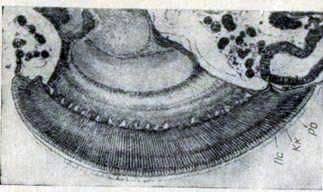
Fig. 53. Cut through the eye of the bee. The rosary sheath; Kc is the crystalline cone; Ps – retina rods. In the upper part of the eye, when preserved, the cornea exfoliates somewhat from the crystalline cone.
Thus, the complex eye of a working bee consists of approximately 5,000 tightly fitting eye wedges to one another, all of which – and this is very important – are located in the longitudinal direction with a slight inclination inward relative to each other, so that none of them looks in the same direction as the other. Each tube is dressed in a black opaque sheath like a leg in a stocking.
Once again imagine in the field of vision of the eye a luminous point (A), which emits rays in all directions. These rays fall on the entire surface of the eye. But only 3 of the eye wedge, in the direction of sight of which lies a luminous point, rectilinearly reaching rays will get through the tube to the retinal stick (a). The remaining eye wedges, upon which the light falls somewhat obliquely, absorb it with their black shells, before it reaches their photosensitive retina. The other point (B) located above lies in the direction of vision of the eye wedge located higher, and the lower point (C) will be appropriately perceived by the eye wedge located below which will transfer it to the retina (see Figure 52).
This also applies to innumerable points, of which, as we can imagine, is an object. Each eye wedge, as it were, snatches from the entire field of view a small particle located in the direction of its view. Thus, as follows directly from the figure, an image appears on the retina, but not inverted, as in the eye with the lens. The order of the location of the image points on the retina corresponds to their actual location, so the image on the retina is straight.
This circumstance has been discussed many times. But in itself it does not have a significant significance and is a natural consequence of differences in the process of the appearance of images on the retina. At the bee, already on the surface of the eye, the picture of the whole field of vision breaks up into a mosaic of the smallest pieces of the image transmitted through the individual eye wedges to the retinal rods and hence to the brain. In our eye, the lens throws a single inverted image onto the retina, which is decomposed by the retinal chopsticks into a mosaic and transmitted to the brain. To connect separate “pebbles” of a mosaic image into a single imaginary image is already a task of the brain.
In Fig. 52 this process of the appearance of the image is shown in an enlarged and simplified form. How elegantly and uniformly in fact the eye wedges are adjacent to each other and how numerous they are, the microphotography of the incision through the eye of the bee gives an idea (see Figure 53).
The visual acuity of the bee and the perception of the shape of objects.
Now, of course, it would be interesting to know how sharply the eye of an insect can see objects of the environment. After all, in its structure, it is significantly different from our bodies of sight. There are various ways to find some starting points for this study.

Fig. 54. Micrograph of the image that appears on the retina of the eye of a firefly (120-fold magnification). Through the window glass the church is visible, on one window glass there is a letter R pasted on it from black paper.
The most obvious thing would be a direct examination. We managed to get the image of the object as it occurs in the eye wedge of the firefly, on its reticulated shell, and magnifying it under a microscope, fix it on the photographic plate. The picture shows a view from the window: it’s easy to recognize the window bindings, the letter R pasted on the glass and even the bell tower in the distance – all of this we see with the eyes of a firefly.
We took for experience just this small insect, because its front-line eye wedges are strengthened on chitin and therefore do not fall apart if the eye is cut off with a very thin scalpel. In this way, it is possible to separate the entire set of eye wedges from the reticular shell, consider the image thrown by them through a microscope and photograph it. Compared to the perception of a normal human eye, it seems very vague.
The same conclusion is given by an anatomical study. The mesh shell of the insect’s eye points out the more details, that is, the sight can be all the sharper, the more there are the eye wedges. This can be compared with a mosaic picture, which will have a greater similarity with the object depicted on it in all its details, the more mosaic stones used to create it.

In Fig. 55 eyes And can not perceive separately three points, since they fall into the area of sight of the same eye wedge, which corresponds to the same rod of the retina. Eye B can perceive them separately, since in this case they are displayed in different eye wedges. It is clear that the smaller the angle of view of each individual eye, the better its ability to spatial decomposition of the object.
The magnitude of this angle in the bee eye approaches one degree. Therefore, two points that appear in the field of view at a smaller angle can not be considered separately from each other. A sharp human eye can perceive separately two points, located one from another at a distance of only one minute of the arc (1/60 degree). The visual acuity of the bee must therefore be many times lower than the visual acuity of the person.
A friend of bees will have to come to terms with the fact that many details of a diverse and beautiful nature remain hidden from his favorites. Of course, it would be interesting to have about this more accurate representation of the bees can “question” by applying a way of training. With the help of this method, it is easy to teach them with great certainty to distinguish the shapes of the flowers depicted in Fig. 56.

However, further investigation revealed that the bees, obviously, are oriented at the same time in other basic features than we do. Most clearly this is evident when applying simple geometric figures. Despite long attempts, it is not possible to force bees to distinguish such completely disparate figures as the triangle, circle, square and rectangle.

But it is even more surprising that bees confuse the figures of the lower row with one another and, on the contrary, they can quickly and confidently distinguish each figure of the lower row from any figure of the upper row. From this (and also on the basis of other experiments repeated many times), it can be concluded that for the bee eye, a secondary attribute of figures, the degree of their dismemberment, is of decisive importance. The figures of each of these two groups – dissected with a diverse contour or undifferentiated with a simple contour-seem to bees very similar or even identical. This leads to the fact that in experiments on training to study the feelings of form they are completely unable to solve very simple problems for us.
Another perception of the shape of objects by bees is due to the fact that their vision organs are immobile. The bee can not rotate eyes and look at the object that interested it. All its 10 000 eyes are firmly fixed on the head to the right and left and are installed in all directions. In flight, she sees them simultaneously the entire panorama under herself and around, and the impressions that individual eyes receive from flashing objects change continuously and very quickly.
If a flash of light is produced in a dark room in rapid succession, then the impression of a flickering light is created. When more than 20 flashes follow each other for one second, our eyes no longer perceive them separately and give the impression of continuous illumination. It is this phenomenon that is widely used in cinematography, where the effect of continuous motion is created as a result of a second-to-second shift of 99-25 frames of a film. We do not notice that after a certain fraction of a second a darkening occurs, during which the image changes.
If there was a movie in the bees’ state.
The projector would have to be done in a completely different way. For the same time, before the bees would have to skip more than 200 individual images, so they did not complain about “flickering.” Eye bees for a second can perceive separately 10 times more independent impressions than our eyes. Therefore, the bee-eye is brilliantly adapted to the perception of movement and the grasp of rapidly changing impressions, when during the flight before the bee flies immovable objects by themselves.
The insignificant capacity for spatial decomposition is compensated by the exceptional ability to analyze events in time. Therefore, it is clear that bees pay much more attention to changes occurring in the field of vision than to calm forms and closed surfaces, and that in their memory, first of all, strongly dissected light and color images are imprinted. Here’s how you can imagine all this. Of course, to know the truth and even for a moment to see the world as the bee sees it is the cherished desire of every inquisitive natural scientist.
Perception of polarized light.
Most people do not know anything about “polarized light”. They are not even interested in them. After all, in order to understand how often we, without even suspecting this, see such a light, we need to use special equipment. At school, we taught that light is electromagnetic waves of a certain length, which spread with monstrous rapidity in space. In this case, there are oscillations perpendicular to the direction of the light beam (transverse vibrations). In the natural sunlight, the orientation of the plane of these oscillations can be any, in particular, can change incessantly.
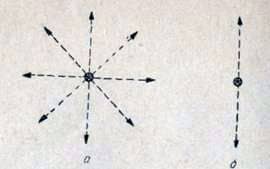
Fig. 58. Scheme explaining the difference between ordinary light (a) and polarized (b).
In Fig. 58, while a ray of light directed straight at us is depicted conditionally in the form of a dot, the dashed lines indicate some alternating directions of oscillations. In polarized light (for example, in a plane-polarized beam), all the oscillations occur in the same plane.
In nature, polarized light is not uncommon. Sunlight reflected by a mirror, water surface or wet street asphalt, is partially (and in some cases completely) polarized. The blue sky is richly polarized; we do not notice it, because for our eye there is no difference between ordinary and polarized light. But for the eyes of insects and other arthropods, polarized light is something special. They can even recognize the direction of its oscillations and use them for orientation in space. This also applies to our bees. This ability was discovered by them several years ago.
Polarized light can be created and artificially, for example, using the prism of Nicolas. Recently, large transparent polarizers have also been made, which fully polarize the rays passing through them. Owing to these auxiliary means, it is not difficult to establish whether light, whose properties we know nothing, is polarized and what will be the direction of its oscillations under the appropriate conditions.
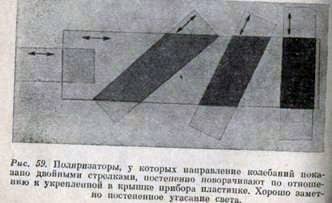
This can be visually demonstrated as follows. From the polarizer, oblong plates are cut out so that the direction of the oscillations of the light passing through them is parallel to the long side of the rectangle. We can not by direct perception determine that light is polarized. In this way or that it is generally polarized. We will not notice anything unusual either, if we place the second filter in the same position in the same position, because with this arrangement the light polarized in the first polarizer can pass unimpeded through the second filter. Overlapped places will appear somewhat less transparent due to the fact that filters have a weak color and two filters, naturally, absorb more light than one.
If we gradually turn one filter in the opposite direction to the other, the light will darken more and finally, when the filters are perpendicular to each other, it completely disappears. Crossing at right angles to the first, the second polarizer becomes completely impermeable to the light vibrations that arise in the first: when the second polarizer is tilted, only a part of the light passes through it. The intensity of such light will decrease the more, the stronger the direction of the oscillations of light passing through both polarizers, will deviate one from the other.
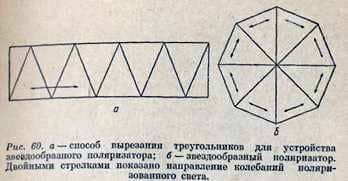
A somewhat different arrangement of the polarizers approaches the conditions arising in the insect’s eye, we cut out such isosceles triangles from the polarizer so that the direction of the oscillations of the light passing through them goes parallel to the base of each triangle, and we arrange them in the form of a star.
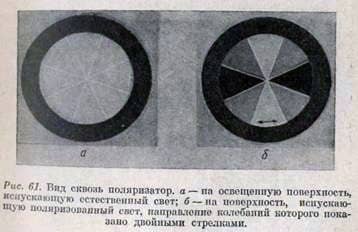
If we look through this star-shaped polarizer on a light surface emitting natural light, then all triangles will appear equally light and we do not know that we see light polarized in different directions. But if we look through the same polarizer to the surface from which the polarized light passes, then depending on the variation of the plane of oscillations of the light incident on them, the illumination of the triangles will change as shown in Fig. 59.
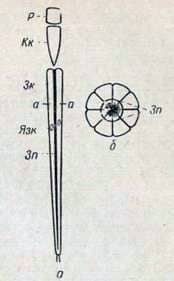
Fig. 62. a is the individual eye of the complex eye of the bee (see Figure 52), greatly enlarged; b – transverse section through a separate eye made along the a-a line (an even larger increase); ъЛ – the visual cell; Yazk is the nucleus of the visual cell; Zn – visual wand (internal, as assumed, photosensitive part of the visual cell); Kc is the crystalline cone; P – cornea (chitinous membrane).
A similar phenomenon, which makes it possible to recognize the directions of the oscillations of polarized light, occurs in the facetted eye. With a strong increase and careful consideration, it turns out that the retinal rods are formed by a group of eight sensitive cells and accordingly consist of eight parts, like our star-shaped polarizer. Similarity is not only external – in a similar way, the fluctuations of light also equalize. Obviously, there is an apparatus that gives the facetted eye an advantage over ours and makes it capable of perceiving polarized light.
The eyes of the bees and their ability to see
